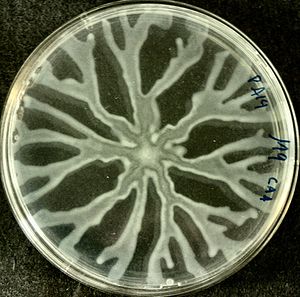
Swarming motility
Encyclopedia
Swarming motility is a rapid (2–10 μm/s) and coordinated translocation of a bacterial population across solid or semi-solid surfaces. This type of motility is an example of an emerging concept in microbiology : bacterial multicellularity. Swarming motility was first reported by Jorgen Henrichsen and has been mostly studied in genus Serratia
, Salmonella
, Aeromonas
, Bacillus
, Yersinia, Pseudomonas
, Proteus
, Vibrio
and Escherichia
.
This multicellular behavior has been mostly observed in controlled laboratory conditions and relies on two critical elements: 1) the nutrient composition and 2) viscosity of culture medium (i.e. % agar). One particular feature of this type of motility is the formation of dendritic fractal-like patterns formed by migrating swarms moving away from an initial location. Although the majority of species can produce tendrils when swarming, some species like Proteus mirabilis
do form concentric circles motif instead of dendritic patterns.

. Biosurfactant molecules are thought to act by lowering surface tension, thus permitting bacteria to move across a surface.
Serratia
Serratia is a genus of Gram-negative, facultatively anaerobic, rod-shaped bacteria of the Enterobacteriaceae family. The most common species in the genus, S. marcescens, is normally the only pathogen and usually causes nosocomial infections. However, rare strains of S. plymuthica, S. liquefaciens,...
, Salmonella
Salmonella
Salmonella is a genus of rod-shaped, Gram-negative, non-spore-forming, predominantly motile enterobacteria with diameters around 0.7 to 1.5 µm, lengths from 2 to 5 µm, and flagella which grade in all directions . They are chemoorganotrophs, obtaining their energy from oxidation and reduction...
, Aeromonas
Aeromonas
Aeromonas is a gram-negative, facultative anaerobic rod that morphologically resembles members of the family Enterobacteriaceae. Fourteen species of Aeromonas have been described, most of which have been associated with human diseases. The most important pathogens are A. hydrophila, A. caviae, and...
, Bacillus
Bacillus
Bacillus is a genus of Gram-positive, rod-shaped bacteria and a member of the division Firmicutes. Bacillus species can be obligate aerobes or facultative anaerobes, and test positive for the enzyme catalase. Ubiquitous in nature, Bacillus includes both free-living and pathogenic species...
, Yersinia, Pseudomonas
Pseudomonas
Pseudomonas is a genus of gammaproteobacteria, belonging to the family Pseudomonadaceae containing 191 validly described species.Recently, 16S rRNA sequence analysis has redefined the taxonomy of many bacterial species. As a result, the genus Pseudomonas includes strains formerly classified in the...
, Proteus
Proteus (bacterium)
Proteus is a genus of Gram-negative Proteobacteria.-Clinical significance:Three species—P. vulgaris, P. mirabilis, and P. penneri—are opportunistic human pathogens. Proteus includes pathogens responsible for many human urinary tract infections. P. mirabilis causes wound and urinary...
, Vibrio
Vibrio
Vibrio is a genus of Gram-negative bacteria possessing a curved rod shape, several species of which can cause foodborne infection, usually associated with eating undercooked seafood. Typically found in saltwater, Vibrio are facultative anaerobes that test positive for oxidase and do not form...
and Escherichia
Escherichia
Escherichia is a genus of Gram-negative, non-spore forming, facultatively anaerobic, rod-shaped bacteria from the family Enterobacteriaceae. In those species which are inhabitants of the gastrointestinal tracts of warm-blooded animals, Escherichia species provide a portion of the...
.
This multicellular behavior has been mostly observed in controlled laboratory conditions and relies on two critical elements: 1) the nutrient composition and 2) viscosity of culture medium (i.e. % agar). One particular feature of this type of motility is the formation of dendritic fractal-like patterns formed by migrating swarms moving away from an initial location. Although the majority of species can produce tendrils when swarming, some species like Proteus mirabilis
Proteus mirabilis
Proteus mirabilis is a Gram-negative, facultatively anaerobic, rod shaped bacterium. It shows swarming motility, and urease activity. P. mirabilis causes 90% of all Proteus infections in humans.-Diagnosis:...
do form concentric circles motif instead of dendritic patterns.

Biosurfactant, quorum sensing and swarming
In some species, swarming motility requires the self-production of biosurfactant to occur. Biosurfactant synthesis is usually under the control of an intercellular communication system called quorum sensingQuorum sensing
Quorum sensing is a system of stimulus and response correlated to population density. Many species of bacteria use quorum sensing to coordinate gene expression according to the density of their local population. In similar fashion, some social insects use quorum sensing to determine where to nest...
. Biosurfactant molecules are thought to act by lowering surface tension, thus permitting bacteria to move across a surface.

